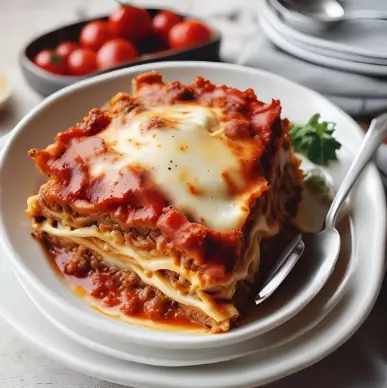Introduction
Lasagna, a dish that has warmed the hearts and homes of many for centuries, is a culinary masterpiece from Italy. Its origins date back to ancient Greece, where the term ‘lasagnum’ referred to a cooking pot rather than the dish we know and love today. The Romans later adopted this term, and it eventually evolved into the delicious layered pasta dish during the Middle Ages in Naples, Italy.
The evolution of lasagna is a fascinating journey through time. The ancient Greeks used the word ‘lasagnum’ to refer to a dish, not the food itself. This term was later borrowed by the Romans and became ‘lasanum’, which was used to describe a cooking pot. The food that was cooked in this pot was called ‘lasana’ or ‘lasanum’, which is where the term lasagna comes from.
In the early days, lasagna did not look like the dish we know today. The first recorded recipe in the 2nd century cookbook “Apicius” was quite simple and did not include any meat. It was just layers of pasta and cheese. The modern version of lasagna, with its layers of pasta, meat, and cheese, did not appear until the Middle Ages. And it was not until the 19th century that tomatoes were added to the mix.
Ingredients
The beauty of lasagna lies in its layers, each one packed with flavor and texture. Here are the key ingredients:
- Lasagna Noodles: The foundation of our dish. Opt for either fresh or dried noodles. Fresh noodles tend to be lighter and more delicate, while dried ones have a firmer texture.
- Meat Sauce (Ragu): A rich, slow-cooked sauce typically made with ground beef, tomatoes, onions, celery, and carrots. The meat provides a hearty, robust flavor, while the vegetables add a touch of sweetness.
- Bechamel Sauce: A creamy white sauce made from butter, flour, and milk. It adds a velvety richness and helps bind the layers together.
- Cheese: Traditionally, Parmigiano-Reggiano and mozzarella are used. Parmigiano-Reggiano offers a nutty, savory depth, while mozzarella gives that delightful, stringy meltiness.
Each ingredient in a lasagna plays a crucial role. The lasagna noodles form the structure of the dish. They are like the walls of a building, supporting the layers of filling. The choice between fresh and dried noodles can greatly affect the texture of the lasagna. Fresh noodles, made with eggs, have a tender, delicate texture that is perfect for light, vegetable-based lasagnas. Dried noodles, on the other hand, are more robust and are ideal for heavier, meat-based lasagnas.
The meat sauce, or ragu, is the heart of the lasagna. It is usually made with ground beef, but can also be made with pork, veal, or a combination of meats. The meat is cooked with a soffritto of onions, celery, and carrots, which gives the sauce a sweet, aromatic base. Tomatoes are then added and the sauce is left to simmer until it is rich and flavorful.
The bechamel sauce, also known as white sauce, adds a creamy, velvety layer to the lasagna. It is made by cooking together butter and flour to form a roux, then gradually whisking in milk until the sauce is smooth and thick. Some recipes also add a pinch of nutmeg for a hint of warmth and complexity.
Cheese is the final key ingredient in lasagna. Parmigiano-Reggiano and mozzarella are the traditional choices. Parmigiano-Reggiano is a hard, granular cheese with a complex, savory flavor that adds depth to the lasagna. Mozzarella is a soft, mild cheese that melts beautifully, creating that irresistible, stringy cheese pull that is a hallmark of a good lasagna.
Optional Ingredients
- Vegetables: Spinach, bell peppers, or zucchini can add a fresh crunch and vibrant color.
- Alternative Proteins: For a twist, try substituting the beef with ground turkey, chicken, or a plant-based alternative. Each brings a unique flavor profile.
- Herbs and Spices: Basil, oregano, and thyme can enhance the flavor. A pinch of nutmeg in the bechamel sauce can add warmth and complexity.
While the four key ingredients form the backbone of a lasagna, there are many ways to customize the dish to your liking. Vegetables such as spinach, bell peppers, and zucchini can add a fresh, crunchy element to the lasagna. They can be sautéed with the soffritto, layered raw in the lasagna, or puréed and mixed into the sauce.
If you want to experiment with the protein, there are plenty of options. Ground turkey or chicken can be used in place of beef for a lighter lasagna. For a vegetarian version, try a plant-based meat substitute or a mix of hearty vegetables like mushrooms and eggplant.
Herbs and spices are another way to customize your lasagna. Basil, oregano, and thyme are classic Italian herbs that complement the flavors of the meat and tomatoes. For a bit of warmth and complexity, try adding a pinch of nutmeg to the bechamel sauce.
Step-by-Step Directions
- Preparation: Preheat your oven to 375°F (190°C). If you’re using dried lasagna noodles, cook them according to the package instructions.
- Making the Meat Sauce: In a large pan, sauté the onions, celery, and carrots until soft. Add the ground beef and cook until browned. Stir in the tomatoes and let the sauce simmer for about 45 minutes.
- Preparing the Bechamel Sauce: In a separate pot, melt the butter, then stir in the flour to create a roux. Gradually whisk in the milk until the sauce is smooth and creamy.
- Layering the Lasagna: In a baking dish, spread a layer of meat sauce, followed by a layer of noodles, a layer of bechamel sauce, and a sprinkle of both cheeses. Repeat these layers until all ingredients are used, finishing with a final layer of cheese on top.
- Baking: Cover the dish with foil and bake for 25 minutes. Then, remove the foil and bake for another 25 minutes, or until the cheese is golden and bubbly.
- Serving: Let the lasagna rest for 15 minutes before slicing. This allows the layers to set and makes serving easier.
Making a lasagna may seem daunting, but it’s actually quite straightforward. The key is to take it one step at a time.
Start by preheating your oven and preparing your noodles. If you’re using dried noodles, be sure to cook them until they’re al dente, or firm to the bite. This will prevent them from becoming too soft and mushy in the lasagna.
Next, make the meat sauce. Sauté the onions, celery, and carrots until they’re soft and fragrant. This mixture, known as a soffritto, forms the base of many Italian dishes. Add the ground beef and cook it until it’s browned. Then, stir in the tomatoes and let the sauce simmer. The longer it simmers, the more flavorful it will be.
While the meat sauce is simmering, you can prepare the bechamel sauce. Melt the butter in a pot, then stir in the flour. This mixture, called a roux, will thicken the sauce. Gradually whisk in the milk, making sure to break up any lumps. Continue cooking the sauce until it’s thick and creamy.
Now comes the fun part: layering the lasagna. Start with a layer of meat sauce, then add a layer of noodles. Spread a layer of bechamel sauce over the noodles, then sprinkle on some cheese. Repeat these layers until all your ingredients are used up. Be sure to finish with a layer of cheese on top; this will give your lasagna a golden, bubbly crust.
Cover the lasagna with foil and bake it in the preheated oven. The foil will prevent the top from browning too quickly. After about 25 minutes, remove the foil and continue baking the lasagna until the cheese is golden and bubbly.
Finally, let the lasagna rest for about 15 minutes before serving. This will allow the layers to set, making it easier to slice and serve.
Conclusion
Lasagna, with its rich history and even richer flavors, is more than just a dish—it’s a labor of love. Whether you stick to the traditional recipe or make it your own with different ingredients, one thing’s for sure: every bite of this layered delight promises a taste of Italy’s culinary heritage. So why wait? Don your apron and start your lasagna adventure today!








